Geotimes

Untitled Document

Web Extra
Thursday, October 14, 2004
Mount St. Helens activity updates
Web
Extra Thursday, October 14, 2004
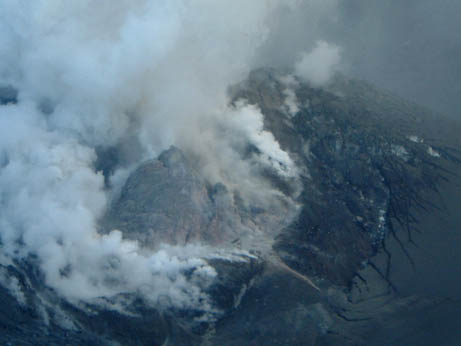 Mount
St. Helens grows new lava dome
Mount
St. Helens grows new lava dome
"I want to remind everyone that we are still dealing with a restless volcano,"
said Tina Neal, a geologist with the U.S. Geological Survey (USGS) in a daily
press conference on Oct. 13. Mount St. Helens in Washington remains at a level
2 advisory, which means that there is a significant chance of hazardous volcanic
activity, but geologists do not believe a "life- or property-threatening
event" is imminent.
Mount St. Helens has been growing a new
lava dome on the south side of the old one, which grew from 1980 through 1986.
In the night sky, it can be seen glowing red from a number of vantage points.
Temperatures have measured close to 700 degrees Celsius on the new growth. All
photos courtesy of the U.S. Geological Survey.
In the weeks since Mount St. Helens first began shaking to life with thousands
of tiny earthquakes, seismic activity has waxed and waned before and following
large steam-and-ash eruptions. Since Oct. 6, however, seismic activity has remained
at low levels, with low-frequency events that are consistent with the intrusion
of gas and magma just below the surface.
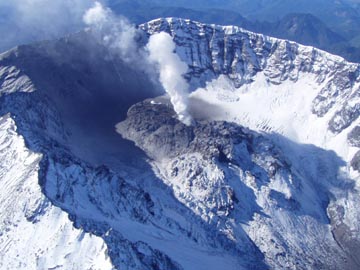 One
of the more interesting things geologists have been watching is the growth of
a new lava dome on the south side of the existing lava dome, which grew from
1980 through 1986, the last time a major eruption occurred on the volcano. New
lava is glowing red at the surface of the new and still-growing fin-shaped dome,
and temperatures of the rock have been measured as high as 690 degrees Celsius.
One
of the more interesting things geologists have been watching is the growth of
a new lava dome on the south side of the existing lava dome, which grew from
1980 through 1986, the last time a major eruption occurred on the volcano. New
lava is glowing red at the surface of the new and still-growing fin-shaped dome,
and temperatures of the rock have been measured as high as 690 degrees Celsius.
Researchers have not yet figured out how large the new dome is, but preliminary
measurements suggest it has grown more than 400 feet over the past two weeks.
If new lava continues to escape and build the dome, it could easily dwarf the
old lava dome, Neal said. The lava dome growth is as expected with the extrusion
of magma, Neal said, and incandescence, including a rosy glow in the sky at
night, will continue to be viewable as weather permits.
New growth of a lava dome in the crater
on Mount St. Helens can be seen on the upper side of an existing lava dome.
Steam continues to leak from cracks on the dome.
GPS instruments at various points on the volcano have recorded little deformation
outside of the dome. Thus, the chance of a cataclysmic eruption such as what
occurred in 1980 is highly unlikely. Before that eruption, the northern flank
was deforming several feet per day.
Over the past few days, USGS has deployed a new suite of instruments on the
volcano, Neal said, including a seismometer, tilt-meters and new GPS instruments
to measure the growth and expansion of the dome, and microphones to record sounds
of explosions or gas releases. "We're still figuring out what's coming
in," Neal said, but they expect to have new results every day. Additionally,
when weather permits, geologists are making daily flights over the crater to
measure gas and thermal levels.
The probability of an endangering eruption is significantly less than at any
time since Oct. 2 when the alert level was raised, USGS said. Geologists caution,
however, that escalation in unrest and even an eruption could occur suddenly
and without warning. Steam-and-ash eruptions as well as growth of the lava dome
will likely continue for weeks to months.
Megan Sever
Links:
Seattle
Times coverage
Mount
St. Helens VolcanoCam
U.S.
Geological Survey Cascades Volcano Observatory
Back to top
Untitled Document

Web
Extra Wednesday, October 6, 2004
Mount St. Helens alert level
lowered: activity continues
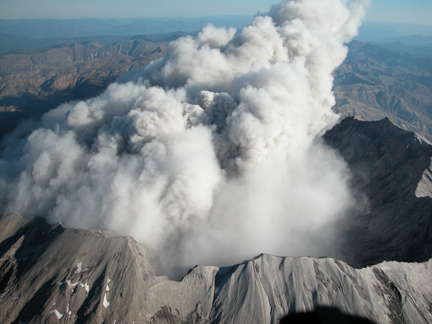 On
Oct. 6, the U.S. Geological Survey (USGS) lowered the alert level for Mount
St. Helens in Washington from a Level 3 Volcano Alert to a Level 2 Volcano Advisory,
in response to lowered seismicity since the previous day's steam-and-ash eruption.
Geologist Willie Scott said the scientists no longer believe that an eruption
is imminent.
On
Oct. 6, the U.S. Geological Survey (USGS) lowered the alert level for Mount
St. Helens in Washington from a Level 3 Volcano Alert to a Level 2 Volcano Advisory,
in response to lowered seismicity since the previous day's steam-and-ash eruption.
Geologist Willie Scott said the scientists no longer believe that an eruption
is imminent.
A Volcano Advisory indicates that "processes are underway that have significant
likelihood of culminating in hazardous volcanic activity" but the evidence
does not indicate that a "life- or property-threatening event is imminent."
According to USGS, seismic activity Tuesday and Wednesday has been at "very
low levels," with individual earthquakes being "rare." Scientists
observed weakened steam emissions from the crater, and suggested that a lack
of rockfall and earthquake signals indicate that deformation of the uplift area
has slowed. The area had uplifted more than 100 feet since activity began last
week.
Mount St. Helens explosively erupted
ash and steam again on Tuesday, sending the mixture several thousand feet above
the crater rim and blanketing nearby towns with a thin layer of ash. Since this
explosion, however, activity has quiesced, leading U.S. Geological Survey geologists
to lower the alert level. Photo courtesy of USGS.
The scientists said that the probability of an endangering eruption is significantly
less than at any time since Saturday when the alert level was raised. They caution,
however, that escalation in unrest and even an eruption could occur suddenly
and without warning. Steam-and-ash eruptions will likely continue for weeks
to months.
Geologists will continue to monitor the volcano to see what happens next.
Megan Sever
Links:
Article
on MSNBC.com
Seattle
Times coverage
Mount
St. Helens VolcanoCam
U.S.
Geological Survey Cascades Volcano Observatory
Past related Geotimes stories:
"Paths
of Destruction: The Hidden Threat at Mount Rainier," April 2004
"Mount
St. Helens 20 Years Later: What We've Learned," May 2000
Back to top
Web
Extra Friday, October 1, 2004 Updated
October 4
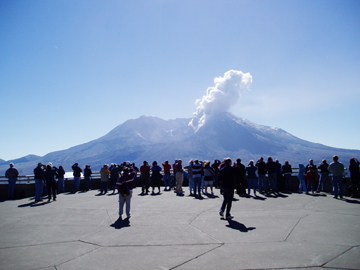 Mount
St. Helens erupts steam and ash
Mount
St. Helens erupts steam and ash
More than a week after seismic activity began, Mount St. Helens in Washington
erupted on Friday afternoon with a thick plume of white steam and light ash.
Since then, additional steam-and-ash emissions have occurred and will likely
continue, prompting officials on Saturday to raise the alert level to Volcano
Alert, which is the highest level and indicates that an eruption could be imminent.
Aviation warnings are at color-code Red, also the highest level. Parts of the
surrounding area, including the Johnston Ridge Observatory, have been evacuated
as a precaution.
Mount St. Helens has erupted several
times since its initial steam-and-ash eruption on Friday, pictured here. Geologists
are constantly monitoring the volcano for signs of further activity. All photos
courtesy of the U.S. Geological Survey.
Although seismicity quieted down at first after Friday's 24-minute eruption,
it picked back up again within a few hours, with small earthquakes (maximum
magnitude-3.0) occurring at rates of one to two per minute. The next day, the
volcano had another small eruption of steam and ash. After yet another small
eruption on Sunday night, the volcano awoke on Monday morning with two eruptive
events.
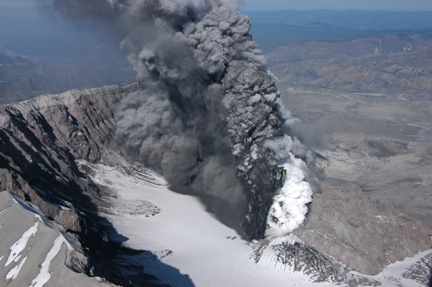 Monday's
events, however, are different from the previous few days' steam-and-ash eruptions,
said geologist Willie Scott in a press conference held by the U.S. Geological
Survey's Cascades Volcano Observatory. Two eruptive clouds, which looks to be
predominantly, if not all, steam, rose several thousand feet above the summit
of Mount St. Helens, but were not accompanied by seismic signals or waves that
indicate movement, he said. Instead, the steam events indicate that magma or
gas must have moved close to the surface and to the glacier, and have basically
started "boiling the glacier" to produce steam. Hot gases from the
volcano may have vaporized ice and snow contained in the glacier in the summit
crater to produce the steam eruption. Background earthquakes have continued
at the same rate as occurred with the other eruptions, but there was no onset
of larger earthquakes such as occurred prior to the steam-and-ash eruptions
on Friday, Saturday and Sunday.
Monday's
events, however, are different from the previous few days' steam-and-ash eruptions,
said geologist Willie Scott in a press conference held by the U.S. Geological
Survey's Cascades Volcano Observatory. Two eruptive clouds, which looks to be
predominantly, if not all, steam, rose several thousand feet above the summit
of Mount St. Helens, but were not accompanied by seismic signals or waves that
indicate movement, he said. Instead, the steam events indicate that magma or
gas must have moved close to the surface and to the glacier, and have basically
started "boiling the glacier" to produce steam. Hot gases from the
volcano may have vaporized ice and snow contained in the glacier in the summit
crater to produce the steam eruption. Background earthquakes have continued
at the same rate as occurred with the other eruptions, but there was no onset
of larger earthquakes such as occurred prior to the steam-and-ash eruptions
on Friday, Saturday and Sunday.
Friday's eruption at Mount St. Helens
was both ash and steam, as seen here. Monday's eruptions were predominantly
steam, indicating that magma is rising toward the surface.
"This is pretty good evidence that we have something very hot near the
surface," Scott said, but it does not indicate any greater or less likelihood
that a magma eruption will occur soon. Scientists are monitoring the volcano
by taking thermal images of the dome and the crater, flying over the volcano
to measure the gases being released and monitoring GPS instruments for ground
deformation. But, Scott said, it is likely the volcano will "go without
any warning at all." If that occurred, the eruption would be rich in ash
that could reach 50,000 feet in altitude, and would produce lava and last tens
of minutes to hours. He said the scientists will be looking for all possible
indications that something bigger is about to occur, but "all options are
open right now. It's best just to watch and see what happens."
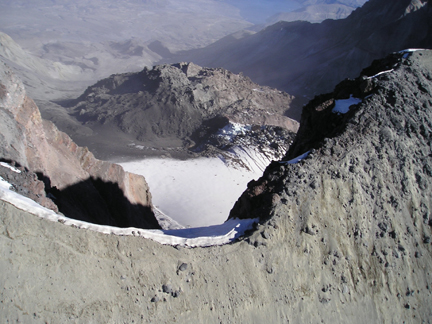 One
interesting thing to note, Scott said, is that the lava dome around the glacier
has seen intense deformation over the past few days — around 100 feet.
Furthermore, new cracks have popped up on the dome and in the glacier —
all indications that "somewhere down the line, we [can] expect an explosive
eruption." The cracks might lead to a greater likelihood of a larger, magma
and ash-rich eruption, Scott said, because the magma would have more escape
options. All of the events so far, he said, have been "expectable."
One
interesting thing to note, Scott said, is that the lava dome around the glacier
has seen intense deformation over the past few days — around 100 feet.
Furthermore, new cracks have popped up on the dome and in the glacier —
all indications that "somewhere down the line, we [can] expect an explosive
eruption." The cracks might lead to a greater likelihood of a larger, magma
and ash-rich eruption, Scott said, because the magma would have more escape
options. All of the events so far, he said, have been "expectable."
The lava dome atop Mount St. Helens
has been growing and deforming significantly since activity began there last
week. It has deformed more than 100 feet, according to USGS geologists.
Indeed, "this is pretty much exactly what we expected to happen,"
says Jim Vallance, a geologist at CVO. From 1981 to 1986, "we saw a lot
of events like this," in which steam and ash erupted and quiesced. The
last eruption of Mount St. Helens was in 1986, six years after the major eruption
on May 18, 1980, that blasted away the entire top and northwest face of the
mountain releasing 24 megatons of thermal energy.
Geologists are continuing to monitor the volcano to see what happens next.
Last updated at 4:00 p.m. EDT, Oct. 4, 2004.
Megan Sever
Links:
Article
on MSNBC.com
Seattle
Times coverage
Mount
St. Helens VolcanoCam
U.S.
Geological Survey Cascades Volcano Observatory
Past related Geotimes stories:
"Paths
of Destruction: The Hidden Threat at Mount Rainier," April 2004
"Mount
St. Helens 20 Years Later: What We've Learned," May 2000
Back to top
Untitled Document

Web
Extra Friday, October 1, 2004
Mount St. Helens could
erupt in days to months
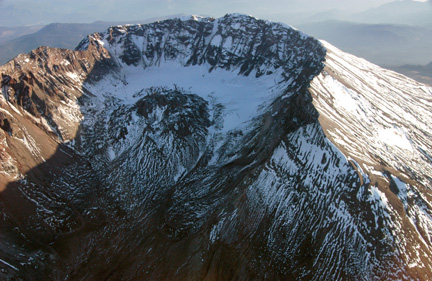 In the
next few days to a month, there's a 70 percent chance that a small to moderate
eruption event will happen at Mount St. Helens, site of the violent and deadly
eruption of May 18, 1980, according to an announcement yesterday by researchers
at the U.S. Geological Survey's (USGS) David A. Johnston Cascades Volcano Observatory
(CVO), in Vancouver, Wash.
In the
next few days to a month, there's a 70 percent chance that a small to moderate
eruption event will happen at Mount St. Helens, site of the violent and deadly
eruption of May 18, 1980, according to an announcement yesterday by researchers
at the U.S. Geological Survey's (USGS) David A. Johnston Cascades Volcano Observatory
(CVO), in Vancouver, Wash.
"But that also means there's a 1 in 3 chance that nothing is going to happen,"
said Cynthia Gardner, a CVO geologist, at Thursday's press conference. "That
word has to get out too."
Scientists now say that Mount St. Helens
in Washington State, the most active volcano in the Cascade Range, has a 70
percent chance of erupting in the next few days to a month. Shown here is an
oblique aerial photograph of the north flank, crater, lava dome and new glacier
(behind dome). U.S. Geological Survey photo taken on Sept. 26 by John S. Pallister.
Based on models of other volcanic events, researchers say that the event could
possibly include any or all of the following: further build-up of the lava dome,
which formed in the crater between 1980 and 1986; possible lava flows outside
the crater, explosive eruption with ballistic rock fragments (from inch to fist-sized)
that could be flung up to 3 miles outside the crater; and an ash plume ejected
to an altitude of hundreds of feet to 20,000 or 30,000 feet. Researchers said
that the latter is the main concern, as it would be hazardous for aircraft.
Gardner said CVO is working with the National Weather Service regarding wind
forecasts.
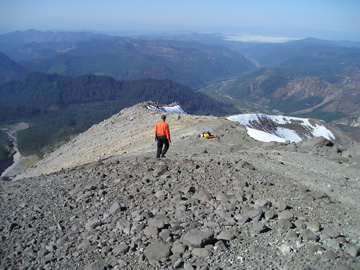 The Johnston
Ridge Observatory Visitor's Center, 5 miles away, is the nearest structure to
the volcano. It remains open and, according to Roger Peterson of the U.S. Forest
Service, has been drawing crowds of 150 to 1,000 onlookers a day to gaze into
the amphitheater-shaped breach of the northwest flank left by the devastating
May 1980 eruption. All trails and backcountry campsites in Gifford Pinchot National
Forest, which contains the mountain, however, have been closed, Peterson added.
The Johnston
Ridge Observatory Visitor's Center, 5 miles away, is the nearest structure to
the volcano. It remains open and, according to Roger Peterson of the U.S. Forest
Service, has been drawing crowds of 150 to 1,000 onlookers a day to gaze into
the amphitheater-shaped breach of the northwest flank left by the devastating
May 1980 eruption. All trails and backcountry campsites in Gifford Pinchot National
Forest, which contains the mountain, however, have been closed, Peterson added.
Throughout the week seismicity has been "ramping up, and plateauing"
repeatedly, Gardner said, at the highest level since 1998. It started last Thursday,
Sept. 23, with an outbreak of small, shallow earthquakes. On Sunday, researchers
set the alert level to level one — Notice of Volcanic Unrest. Activity
then increased such that by Wednesday they raised the alert level to level two
— a Volcano Advisory, which is issued when "monitoring and evaluation
indicate that processes are underway that have significant likelihood of culminating
in hazardous volcanic activity but when the evidence does not indicate that
a life- or property-threatening event is imminent."
A U.S. Geological Survey scientist stands on the West Ridge of Mount St. Helens
this past Tuesday — one of many volcanologists watching the volcano and
trying to undertsand its current activity. USGS photo taken by Mike Poland and
Dan Dzurisin.
As of Thursday afternoon, seismologists at CVO and the University of Washington's
Pacific Northwest Seismograph Network were recording three to four small earthquakes
per minute with magnitudes increasing, from less than 2.0 earlier in the week,
to as large as a 3.3 on Thursday morning. Larger magnitude quakes in the range
of 3.0 to 3.3 were happening every three to four minutes.
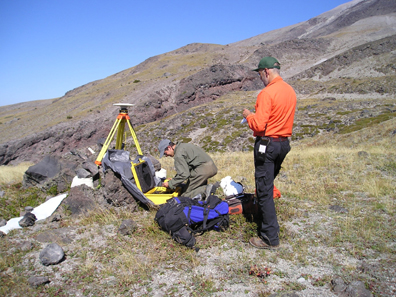 Researchers
said that the increased frequency and magnitude of the seismicity indicates
potential magma involvement under the lava dome. "Our hypothesis now is
that there is some magma involved but that that magma is largely degassed,"
Gardner said.
Researchers
said that the increased frequency and magnitude of the seismicity indicates
potential magma involvement under the lava dome. "Our hypothesis now is
that there is some magma involved but that that magma is largely degassed,"
Gardner said.
According to Bill Steele, information director at the University of Washington's
Pacific Northwest Seismograph Network, researchers previously suspected the
movement of steam or water below the lava dome to be causing earthquakes. This
idea was based on lower magnitude and frequency of the quakes, the absence of
magmatic gases (such as carbon dioxide, sulfur dioxide and hydrogen sulfide)
in the air above the crater, and the fact that the Northwest experienced an
unusually rainy and wet August.
U.S. Geological Survey scientists set up a GPS unit on the flanks of Mount St.
Helens, north of Butte Camp, to help better monitor its recent activity. USGS
photo taken on Sept. 28 by Mike Poland and Dan Dzurisin.
"With steam, we would have expected fracturing and one to one and a half
days of activity," Gardner said, "but certainly not five or six days.
[Steam] may be part of the equation but not all."
Three flights this week over the crater have so far detected no magmatic gases.
Degassed magma would create a much less explosive eruption, while gaseous, volatile
magma would create a much more violent eruption. The scientists said that they
plan to use thermal imaging technology today to determine the temperature of
the lava dome, which will be a better indicator of the presence or absence of
magma.
Early in the week, researchers detected about 1.5 inches of deformation on the
lava dome using a GPS monitor. Additional monitors are on the lip of the crater
and the flanks of the volcano. No deformation has yet been detected on the flanks,
which would be an indication of deeper activity, Gardner said. Prior to the
1980 eruption, the north flank of the volcano bulged outward nearly 450 feet.
For safety reasons, geologists are no longer hiking into the crater; however,
data from the most critical GPS sensors can be collected remotely.
Researchers emphasized they expect nothing like the cataclysmic eruption of
May 18, 1980, that blasted away the entire top and northwest face of the mountain
releasing 24 megatons of thermal energy, ejecting ash and debris 80,000 feet
into the air, and lowering the summit elevation by more than 1,300 feet. The
resulting pyroclastic flows, landslides, and lahars (mudflows) were some of
the largest in recorded history. The eruption claimed the lives of 57 people,
including 30-year-old USGS volcanologist David A. Johnston, who was monitoring
the volcano that morning from the ridge that now bears his name.
Sara Pratt
Geotimes contributing writer
Naomi Lubick contributed to this report.
Links:
Mount
St. Helens VolcanoCam
U.S.
Geological Survey Cascades Volcano Observatory
Past related Geotimes stories:
"Paths
of Destruction: The Hidden Threat at Mount Rainier," April 2004
"Mount
St. Helens 20 Years Later: What We've Learned," May 2000
Back to top
Untitled Document

 Mount
St. Helens grows new lava dome, Oct.
14
Mount
St. Helens grows new lava dome, Oct.
14
 Mount
St. Helens grows new lava dome
Mount
St. Helens grows new lava dome
 One
of the more interesting things geologists have been watching is the growth of
a new lava dome on the south side of the existing lava dome, which grew from
1980 through 1986, the last time a major eruption occurred on the volcano. New
lava is glowing red at the surface of the new and still-growing fin-shaped dome,
and temperatures of the rock have been measured as high as 690 degrees Celsius.
One
of the more interesting things geologists have been watching is the growth of
a new lava dome on the south side of the existing lava dome, which grew from
1980 through 1986, the last time a major eruption occurred on the volcano. New
lava is glowing red at the surface of the new and still-growing fin-shaped dome,
and temperatures of the rock have been measured as high as 690 degrees Celsius.
 On
Oct. 6, the U.S. Geological Survey (USGS) lowered the alert level for Mount
St. Helens in Washington from a Level 3 Volcano Alert to a Level 2 Volcano Advisory,
in response to lowered seismicity since the previous day's steam-and-ash eruption.
Geologist Willie Scott said the scientists no longer believe that an eruption
is imminent.
On
Oct. 6, the U.S. Geological Survey (USGS) lowered the alert level for Mount
St. Helens in Washington from a Level 3 Volcano Alert to a Level 2 Volcano Advisory,
in response to lowered seismicity since the previous day's steam-and-ash eruption.
Geologist Willie Scott said the scientists no longer believe that an eruption
is imminent.  Mount
St. Helens erupts steam and ash
Mount
St. Helens erupts steam and ash  Monday's
events, however, are different from the previous few days' steam-and-ash eruptions,
said geologist Willie Scott in a press conference held by the U.S. Geological
Survey's Cascades Volcano Observatory. Two eruptive clouds, which looks to be
predominantly, if not all, steam, rose several thousand feet above the summit
of Mount St. Helens, but were not accompanied by seismic signals or waves that
indicate movement, he said. Instead, the steam events indicate that magma or
gas must have moved close to the surface and to the glacier, and have basically
started "boiling the glacier" to produce steam. Hot gases from the
volcano may have vaporized ice and snow contained in the glacier in the summit
crater to produce the steam eruption. Background earthquakes have continued
at the same rate as occurred with the other eruptions, but there was no onset
of larger earthquakes such as occurred prior to the steam-and-ash eruptions
on Friday, Saturday and Sunday.
Monday's
events, however, are different from the previous few days' steam-and-ash eruptions,
said geologist Willie Scott in a press conference held by the U.S. Geological
Survey's Cascades Volcano Observatory. Two eruptive clouds, which looks to be
predominantly, if not all, steam, rose several thousand feet above the summit
of Mount St. Helens, but were not accompanied by seismic signals or waves that
indicate movement, he said. Instead, the steam events indicate that magma or
gas must have moved close to the surface and to the glacier, and have basically
started "boiling the glacier" to produce steam. Hot gases from the
volcano may have vaporized ice and snow contained in the glacier in the summit
crater to produce the steam eruption. Background earthquakes have continued
at the same rate as occurred with the other eruptions, but there was no onset
of larger earthquakes such as occurred prior to the steam-and-ash eruptions
on Friday, Saturday and Sunday.  One
interesting thing to note, Scott said, is that the lava dome around the glacier
has seen intense deformation over the past few days — around 100 feet.
Furthermore, new cracks have popped up on the dome and in the glacier —
all indications that "somewhere down the line, we [can] expect an explosive
eruption." The cracks might lead to a greater likelihood of a larger, magma
and ash-rich eruption, Scott said, because the magma would have more escape
options. All of the events so far, he said, have been "expectable."
One
interesting thing to note, Scott said, is that the lava dome around the glacier
has seen intense deformation over the past few days — around 100 feet.
Furthermore, new cracks have popped up on the dome and in the glacier —
all indications that "somewhere down the line, we [can] expect an explosive
eruption." The cracks might lead to a greater likelihood of a larger, magma
and ash-rich eruption, Scott said, because the magma would have more escape
options. All of the events so far, he said, have been "expectable."
 In the
next few days to a month, there's a 70 percent chance that a small to moderate
eruption event will happen at Mount St. Helens, site of the violent and deadly
eruption of May 18, 1980, according to an announcement yesterday by researchers
at the U.S. Geological Survey's (USGS) David A. Johnston Cascades Volcano Observatory
(CVO), in Vancouver, Wash.
In the
next few days to a month, there's a 70 percent chance that a small to moderate
eruption event will happen at Mount St. Helens, site of the violent and deadly
eruption of May 18, 1980, according to an announcement yesterday by researchers
at the U.S. Geological Survey's (USGS) David A. Johnston Cascades Volcano Observatory
(CVO), in Vancouver, Wash. The Johnston
Ridge Observatory Visitor's Center, 5 miles away, is the nearest structure to
the volcano. It remains open and, according to Roger Peterson of the U.S. Forest
Service, has been drawing crowds of 150 to 1,000 onlookers a day to gaze into
the amphitheater-shaped breach of the northwest flank left by the devastating
May 1980 eruption. All trails and backcountry campsites in Gifford Pinchot National
Forest, which contains the mountain, however, have been closed, Peterson added.
The Johnston
Ridge Observatory Visitor's Center, 5 miles away, is the nearest structure to
the volcano. It remains open and, according to Roger Peterson of the U.S. Forest
Service, has been drawing crowds of 150 to 1,000 onlookers a day to gaze into
the amphitheater-shaped breach of the northwest flank left by the devastating
May 1980 eruption. All trails and backcountry campsites in Gifford Pinchot National
Forest, which contains the mountain, however, have been closed, Peterson added.
 Researchers
said that the increased frequency and magnitude of the seismicity indicates
potential magma involvement under the lava dome. "Our hypothesis now is
that there is some magma involved but that that magma is largely degassed,"
Gardner said.
Researchers
said that the increased frequency and magnitude of the seismicity indicates
potential magma involvement under the lava dome. "Our hypothesis now is
that there is some magma involved but that that magma is largely degassed,"
Gardner said.